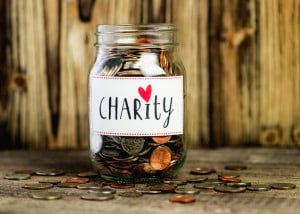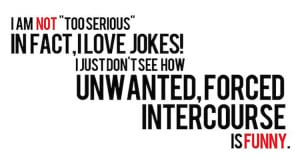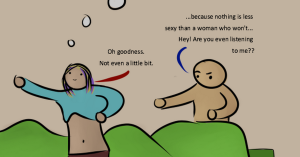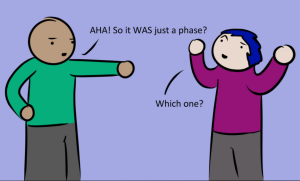The world of advertising is a sinister place.
We’ve all been there. Hanging out, enjoying a nice TV marathon.
All of a sudden, boom! The Guilt Strikes.
A Sarah McLachlan song comes on as a shoeless brown child enters the screen. An elderly white person emerges stage left, wrapping his kindly arm around Timmy and telling you that Timmy doesn’t have shoes to wear to school.
Immobilized, you plead for the commercial to end as you stare out the window, mourning the state of the world.
Just as you think it’ll end, there’s a tone shift.
“Wait right there, viewer!” the commercial says, “You don’t have to feel this way! Instead, buy a pair of cute shoes, and we’ll give a pair to little Timmy, too!”
You log on, make your responsible purchase, and lie down to sleep that night, dreaming dreams of a world without the pain of inequity, in which you’ve done your part.
The reality, however, isn’t so simple. Buying into guilt relief doesn’t create oppression relief. Never has, never will.
Sensing the uncomfortable white guilt of a consumer population increasingly aware of corporate greed and global inequity, businesses and entrepreneurs everywhere have identified an incredibly ripe opportunity for making some extra cash: selling guilt relief.
It’s a genius idea. With responsible consumerism, charity, and buying away capitalism, you can buy away your white guilt.
And it’s everywhere.
Responsible Consumerism: For every watch you buy, WeWood plants a tree “to restore Mother Nature.”
Charity: Pop a few coins into that Salvation Army bucket, and enjoy a guilt-free Walmart shopping trip.
Commercialized Anti-Capitalism: The Gap supports labor rights – they have Che Guevara shirts!
Don’t believe the hype: Not a single one of these actions transfers the white wealth of capitalism – it doesn’t even destabilize it.
The Salvation Army dollars don’t go to the Walmart employees who sleep in shelters at night, the WeWood dollar doesn’t go to replace embattled rain forests in New Guinea, and The Gap’s dollar certainly doesn’t go to support labor rights in Argentina.
Rather, your white guilt has simply been exploited to transfer that ten dollars from your white pocket to another white pocket.
This might hurt a bit to read. And I get it. You’ve done your research and closely examined your privilege.
You’re taking steps in your daily life to disrupt white supremacy by leveraging that privilege. You want this to end, and so part of your work is to transfer the unearned wealth of privilege.
The problem with this is that charity will never dismantle white supremacy or the capitalism it’s in bed with.
The advertising industry isn’t your friend and it doesn’t want to be. Instead, the advertising industry is a professional in the field of manipulating human psychology. It knows better than to state its greedy intentions while pandering to your guilt.
And so, too often, we allow our emotional connection to an imagined, equitable world to be bought and sold.
In this article, we’re going to check out some underhanded ways in which “responsible consumerism,” charity, and commercialized “anti-capitalism” distract us from the roots of inequity and reinforce the status quo of white supremacy and concentrated white wealth.
So come with me as we interrogate exactly what lies are being sold to us when we’re asked to save the world with a few white dollars.
Lie #1: Responsible Consumers Need Not Feel White Guilt
Regardless of how you feel about Whole Foods, you can’t deny that they are a connoisseur of responsible consumerism. Nay, the captain.
At some point in time, Whole Foods looked around and thought, “Huh! Wealthy white folks don’t just want food that tastes good, but they want that food to feel good – and I bet they’d pay for it.”
Brilliant!
With an eye toward profiting from the responsible consumerism niche, Whole Foods’ efforts to create a guilt-free shopping and dining experience are among the most sophisticated around.
In 2014, they launched a massive ad campaign, spending $15-20 million over the course of a year to challenge consumers to prove with our paychecks that “Values Matter.”
Their exact words were, “It’s good for us, and for the greater good, too. This is where it all comes to fruition. This is where values matter. Whole Foods Market, America’s healthiest grocery store.”
And there you have it – not only can you purchase an organic pomegranate year-round, but you can buy a pomegranate in the name of the greater good.
The impact of your fruit purchase can also extend toward addressing racism.
In 2012, Whole Foods entered the “emerging market” that was/is bankrupted Detroit. As they broke ground in a city dubbed The New Bushwick, CEO Walter Robb boldly expressed their lofty mission to local business leaders.
“We’re coming to confront the disconnect between the accessibility and the affordability in healthy food.” At another speech, he told folks the Detroit store was “going after elitism” and “going after racism.”
Who could say no to that?
But chew on that guilt-free pomegranate for a minute before you digest it, because, in reality, your values are being leveraged here to create greater wealth disparities.
Google The Whole Foods Effect and you’ll find that Whole Food’s impact isn’t so much connecting low-income residents to affordable food, but replacing those low-income residents with wealthier, whiter residents who can afford to pay.
The Whole Foods Effect speaks to the displacement of poor residents upon the entry of a Whole Foods into a neighborhood.
Witness Detroit: In 2012, the average home in Midtown (the neighborhood that houses Whole Foods) costs under $100,000. Today, that average has risen to $315,000. The average income for black families in Midtown is $11,400.
So who exactly is that pomegranate supporting, again?
Whole Foods isn’t oblivious to its impact, and it’s on us to interrogate what’s being sold to us as “responsible.” Because it’s through this advertising of responsible consumerism that we become locked in a sinister cycle of buying away our consciousness.
As Detroit becomes a bit whiter, Whole Foods walks away a lot wealthier.
Lie #2: White People Who Donate to Charity Save Poor Black and Brown People
If you are a white person who hasn’t yet seen it, please check out this commercial by the charity Feed a Child.
To recap, a black child follows a white woman around a house as she absentmindedly feeds him scraps from the table and has him sleep outside of the home.
At the end of the commercial, the viewer is challenged: Do you really want to treat black children like your dogs? If you don’t, send money here.
Horrifying, right? But again, this sort of affective advertising is kind of brilliant.
This commercial isn’t only offering the viewer an opportunity to feed a child – this commercial is offering an opportunity to quiet the figurative poor black or brown child nagging at you as you try to enjoy your dinner.
This nagging child represents an awareness of racialized global inequity that accompanies each and every bite we have the privilege to consume.
And offers the viewer an ability to silence that nagging – through purchasing silence with a donation.
The trick isn’t just to get you to buy, but to get at your guilt in a way that denies your ability to name and resist exactly what is happening here.
Whether individual or corporate, donations of this sort don’t challenge the status quo. Don’t get me wrong: Donations aren’t necessarily bad – but the typical purpose of charity isn’t to disrupt systems of power or wealth (unless it’s a donation toward that explicit purpose).
This phenomenon of charity reinforces a narrative of white supremacy.
It tells us those donors (a group largely made up of white, straight, cisgender men and women) are our martyrs and the saviors of poor, helpless people of color worldwide. That white supremacy isn’t a source of oppression, but rather a source of grace. That white supremacy is about who needs to be saved, and who can do the saving.
In his now-infamous 1899 poem The White Man’s Burden, Rudyard Kipling wrote,
Take up the White Man’s burden,
The savage wars of peace—
Fill full the mouth of Famine
And bid the sickness cease.
Mr. Kipling was pretty straightforward about his feels: We’ve got to colonize these folks for their own good!
But if you squint your eyes you’ll notice his sentiment lives on – in the Feed a Child commercial or any holiday letter sent out in December asking for your dollars to feed the children, house the homeless, or educate single mothers.
The difference is that we no longer explicitly name The White Savior Industrial Complex – we just accept that charity is the ethical burden of the white and wealthy.
I mean, if you believe that Values Matter, anyway.
Lie #3: With the Right Purchase, You Can Buy Away Capitalism
Commercialized anti-capitalism is a system through which symbols of social change are sold to consumers for corporate profit (synonyms include Pink Ribbon, Inc.).
Take a prime example: Toms Shoes. Love me some boho chic slip-ons, and hey, it’s for a good cause!
From Toms website: “While traveling in Argentina in 2006, Blake Mycoskie witnessed the hardships faced by children growing up without shoes. His solution to the problem was simple, yet revolutionary: to create a for-profit business that was sustainable and not reliant on donations.”
And, with a lil bit of economic privilege and a lot of white saviorism, Toms Shoes was born! For every pair of Toms shoes you buy, they give a pair to a child in need. Foolproof, no?
Seems so. The charismatic hipster bro at the helm, Mycoskie, is now sitting on a $300 million personal empire as a result of his noble charity.
And, y’all, get this: In 2014, Bain Capital bought 50% of Toms (which is valued at $625 million).
Yes, Bain Capital – the private equity firm owned by Mitt Romney. The private equity firm whose profit is made almost exclusively by skirting tax laws by investing abroad, buying out entire industries to centralize power and sap workers of fair pay, and essentially saying a big ol “F-U” to the oozing wealth gap destroying families and shuttering jobs here in the United States.
But don’t worry, it’s cool. Bain said they’ll still keep up the 1-1 model. So generous.
Bain Capital is very unapologetically creating poverty – the same poverty Toms seeks to address.
And the founder of Toms? Well, his business card reads “Chief Shoe Giver.”
Starting to get the cycle here?
Responsible Consumerism, Charity, and Buying Away Capitalism: Pulling It All Together
So, emotional manipulation of white consumers by capitalist ventures, using empty symbols of social change, ultimately reinforces white supremacy.
Word. It’s a lot.
Let’s imagine an example of how it all comes together.
First, banks and private investment firms like Bain Capital play an undeniable role in the destruction of the businesses providing jobs to cities like Detroit.
Partnered with subprime loans and white flight, economically depressed cities find themselves offering corporate tax breaks that draw big businesses that ultimately remove jobs, tax incomes, and wealth from the city (it’s worth noting that the financial services industry is 81% white; Detroit is 82% black).
Any economic collapse generates extraordinary opportunities for white investors to cheaply buy, re-develop, and re-inhabit.
So, as a black resident of Detroit impacted by job loss, perhaps you’re also finding your property taxes have skyrocketed because of the expensive houses building up around you. Maybe you can’t shop at Whole Foods and purchase a pomegranate to end racism.
In fact, with food and housing options getting more expensive, maybe you have to move out.
Cue the newly arrived white progressive: I just wanted a bigger space for cheaper rent. Things seem tense here. Where did all the black people go? Uh oh. I want to help.
Here comes Whole Foods: Hey, it’s okay. Values matter here.
Here comes Toms, owned by Bain but forever committed to equity: Hey, it’s okay. Buy a pair of shoes and help someone who’s fallen victim to poverty.
And you pay away the guilt.
But as you sleep at night, Toms continues to chase poverty for profit, Bain pushes Toms as an investment to build further capital, and the sinister cycle repeats itself, reinforced by your purchase of guilt relief.
So, ladies and gentlequeers: This is the story of how responsible consumerism, charity, and buying away capitalism reproduce and create white wealth and white supremacy.
You can’t purchase anti-capitalism. You can’t purchase an end to economic disparities. You can’t purchase the end of racism.
So keep your focus trained on the source.
It takes a bit of time to Google past the marketing geniuses of a corporation to track where the profit from your purchase goes, but never take an advertisement at face value. Ever.
And while we’re at it, we’ve got to work to eliminate the need for charity through genuine transfer of wealth. Yes, this means considering reparations.
Charity addresses symptoms, not causes.
I hate to say it, but 10 cents a day isn’t going to eliminate someone’s need for another 10 cents the next day. Especially if eight of those ten cents are going toward the hands that are passing it.
[do_widget id=’text-101′]
Kel Kray is a Contributing Writer for Everyday Feminism. Kel is a fiercely friendly social justice warrior who spends their days advocating with and on behalf of queer youth at an LGBTQIA+ youth center in Philly. A firm believer in the transformative power of dialogue, Kel coordinates a youth-driven education and training program that facilitates community workshops on gender and sexuality with an intersectional lens.
Search our 3000+ articles!
Read our articles about:
Our online racial justice training
Used by hundreds of universities, non-profits, and businesses.
Click to learn more
Most Read Articles
- « Previous
- 1
- …
- 30
- 31
- 32




















